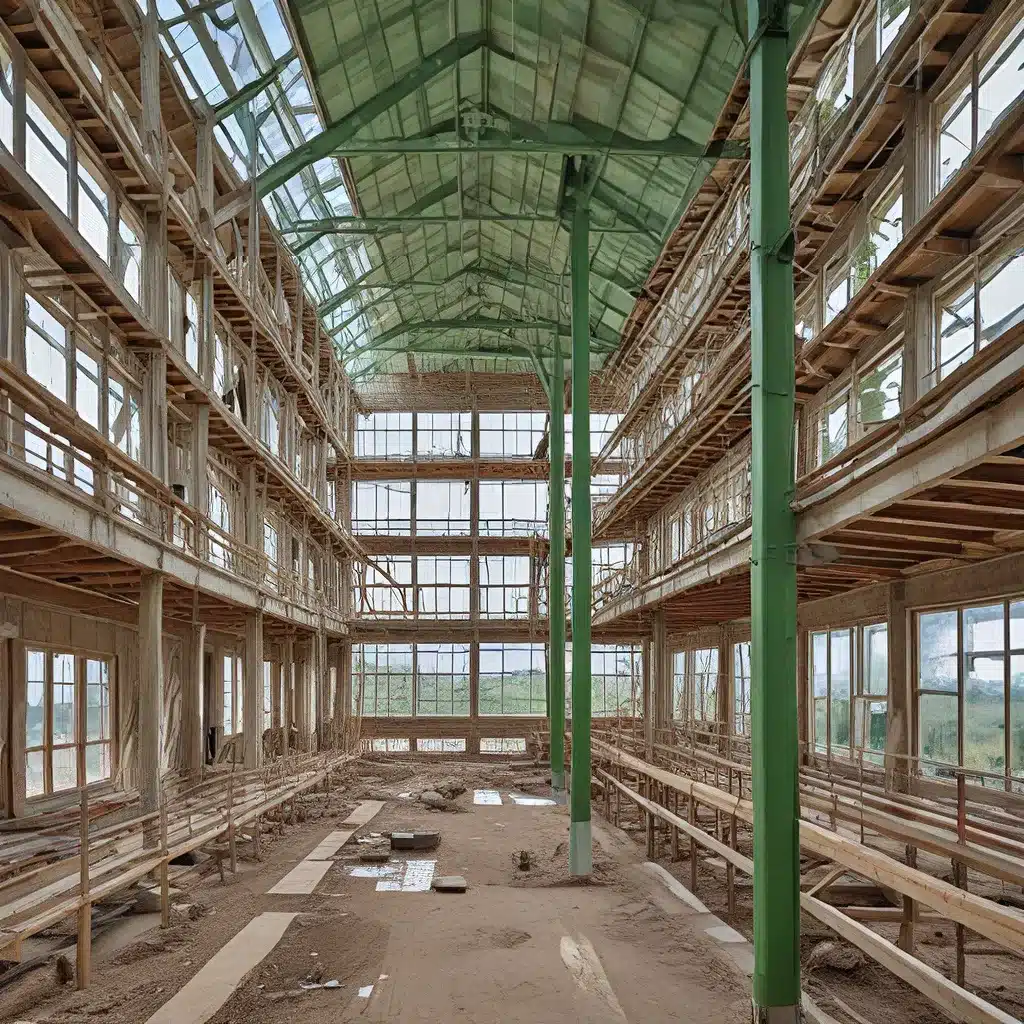
Sustainability in construction – it’s the buzzword that’s been echoing through the industry for years now. But let me tell you, this is no passing fad. The green building revolution is here to stay, and as a general contractor, you’d better be prepared to adapt.
The Greening of the Great Indoors (and Outdoors)
Picture this: You’re sitting in your office, basking in the warm glow of natural light streaming through the windows. The air is crisp and clean, and the soothing sounds of a living, breathing rooftop garden drift in from above. Welcome to the world of sustainable construction, my friends.
The green building landscape is evolving at a breakneck pace, and it’s not just about making structures more energy-efficient. No, this is a holistic revolution that’s transforming every aspect of the built environment – from the materials we use to the way we manage water and waste. And as a general contractor, you need to be at the forefront of these changes.
Industry experts are predicting a surge in demand for sustainable construction solutions, driven by both environmental concerns and the quest for healthier, more efficient buildings. But the road to a greener future isn’t without its challenges. The construction industry is notoriously resistant to change, and integrating new technologies and practices can be a costly and complex undertaking.
Embracing the Evolving Landscape
So, how do you, as a general contractor, adapt to this ever-changing green building landscape? It starts with staying informed and keeping a close eye on the latest trends and innovations.
Trend #1: The Rise of Renewable Materials
Gone are the days of concrete and steel dominance. The sustainable construction world is embracing a new generation of eco-friendly materials, from bamboo and hemp to recycled plastics and even mycelium (that’s right, mushrooms!). These materials not only have a lower environmental impact but can also offer unique design possibilities and enhanced performance characteristics.
As a contractor, it’s crucial to familiarize yourself with these emerging materials and understand their applications, strengths, and limitations. Being an early adopter of innovative sustainable solutions can give you a competitive edge in the market.
Trend #2: The Rise of Smart, Grid-Connected Buildings
The future of green construction isn’t just about energy efficiency – it’s about creating buildings that can actively participate in the broader energy ecosystem. Smart, grid-connected buildings are capable of monitoring their own energy usage, adjusting systems in real-time, and even feeding excess power back into the grid. This not only reduces a building’s carbon footprint but also creates new revenue streams for owners.
As a contractor, you’ll need to be well-versed in the latest smart building technologies, from advanced HVAC systems to integrated renewable energy solutions. Collaborating with specialists in these fields will be crucial to delivering cutting-edge sustainable projects.
Trend #3: The Importance of Adaptive Planning
In the face of a rapidly changing climate, traditional approaches to construction are no longer enough. Adaptive planning is becoming increasingly important, as contractors and designers must anticipate and prepare for the impacts of extreme weather, rising sea levels, and other environmental challenges.
This means rethinking site selection, construction techniques, and even the selection of building materials. It’s no longer enough to simply build for today – you need to be thinking about how a structure will withstand the challenges of tomorrow.
Navigating the Challenges
Of course, embracing these sustainable construction trends isn’t without its challenges. The construction industry is notoriously slow to adapt, and the costs associated with new technologies and practices can be daunting.
Challenge #1: Overcoming Industry Inertia
Change is never easy, and the construction industry is no exception. Many contractors and developers are stuck in their ways, resistant to the idea of incorporating innovative sustainable solutions into their projects. Breaking through this industry inertia requires a multi-pronged approach.
First and foremost, you need to educate your clients on the long-term benefits of sustainable construction. Highlight the cost savings, improved occupant health, and reduced environmental impact. Demonstrate how these investments can pay dividends down the line.
Secondly, you’ll need to invest in your own team’s education and training. Empower your employees to become champions of sustainable practices, equipping them with the knowledge and skills to confidently incorporate green building strategies into their work.
Challenge #2: Managing the Costs
There’s no denying that sustainable construction can come with a higher upfront price tag. But as the old saying goes, “you have to spend money to save money.” The key is to take a long-term view and focus on the lifetime value of your projects.
General contractors who can effectively communicate the cost-saving potential of green building strategies – from reduced energy bills to lower maintenance expenses – will be better positioned to win over skeptical clients.
Additionally, stay on the lookout for innovative financing solutions, such as green bonds and sustainability-linked loans, that can help offset the initial investment. By getting creative with your funding, you can make sustainable construction a more viable option for your clients.
Embracing the Green Building Revolution
The sustainable construction revolution is in full swing, and as a general contractor, you have a crucial role to play. By staying ahead of the curve, embracing new technologies and practices, and effectively communicating the benefits of green building, you can position your business for long-term success in this rapidly evolving landscape.
So, what are you waiting for? It’s time to dive headfirst into the world of sustainable construction and be a trailblazer in the green building revolution. The future is bright, my friends – let’s go make it a little greener.
Related posts:
No related posts.




